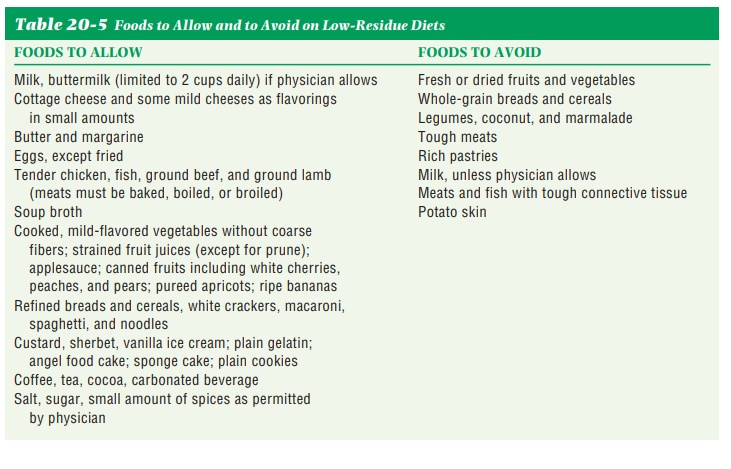Chapter: Nutrition and Diet Therapy: Diet and Gastrointestinal Problems
Residue-Controlled Diets
RESIDUE-CONTROLLED DIETS
Fiber is that part of
food that is not broken down by digestive enzymes. It is called dietary fiber.
Most dietary fiber is found in plant foods. Some is soluble, and some is
insoluble. Examples of dietary fiber in plants include the outer shells of corn
kernels, strings of celery, seeds of strawberries, and the connective tissue of
citrus fruits.
Residue is the solid
part of feces. Residue is made up of all the undigested and unabsorbed parts of
food (including fiber), connective tissue in animal foods, dead cells, and
intestinal bacteria and their products. Most of this residue is composed of
fiber.
Diets can be adjusted
to increase or decrease fiber and residue. The specific names of these diets
vary among health care facilities. The specific foods allowed and thus the
amount of fiber and residue allowed will depend on the physician’s experience
and the client’s condition.
The High-Fiber Diet
High-fiber diets
containing 30 grams or more of dietary fiber are believed to help prevent
diverticulosis, constipation, hemorrhoids, and colon cancer. They also are
helpful in the treatment of diabetes mellitus
and atherosclerosis.
It is currently
estimated that the normal diet in the United States contains about 11 grams of
dietary fiber each day. A high-fiber diet is often 25 to 35 grams and should
not exceed 50 grams a day. The recommended foods for this diet include coarse-
and whole-grain breads and cereals, bran, all fruits, vegetables (especially
raw), and legumes. Milk, meats, and fats do not contain fiber (Table 20-4). The
diet is nutritionally adequate. High-fiber diets must be introduced gradually
to prevent the formation of gas and the discomfort that accompanies it. Eight
8-ounce glasses of water also must be consumed along with the increased fiber.

The Low-Residue Diet
The low-residue diet
of 5 to 10 grams of dietary fiber a day is intended to reduce the normal work
of the intestines by restricting the amount of dietary fiber and reducing food
residue. Low-fiber or residue-restricted diets may be used in cases of severe
diarrhea, diverticulitis, ulcerative colitis, and intestinal blockage and in
preparation for and immediately after intestinal surgery.

In some facilities,
these diets consist of foods that provide no more than 3 grams of fiber a day
and that do not increase fecal residue (Tables 20-5 and 20-6). Some foods that
do not actually leave residue in the colon are considered “low-residue” foods
because they increase stool volume or provide a laxative effect. Milk and prune
juice are examples. Milk increases stool volume, and prune juice acts as a
laxative.

Related Topics